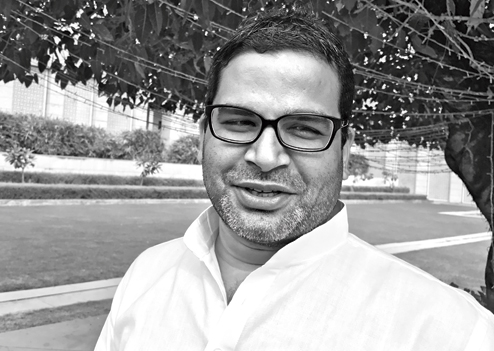
You acquire a big field cannon. You wheel it into your war-room and fete around it as your lead weapon for necessary future battles. It’s a cannon that’s proven itself worthy of the battlefield, not once, but both times it has been deployed. It has fired not one way, but opposite ways, with resounding report and results.
You acquire such a cannon. You acquire it because you think it a thing of value. You have do-or-die challenges closing on you. This cannon you now have has been a sure-fire cannon; you want it to fire for you.
But as the hour approaches to oil the cogs and load the barrel and line the enemy in the cannon’s sights, you run it aground, avert its aim and feed it dust for gunpowder.
Prashant Kishor, 39, must feel a bit like such a cannon on the Congress’ precincts. Pulled in to perform an encore of his stellar strikes of 2014 and 2015 — the first for Narendra Modi, the second against him — then disabled.
It’s been exactly a year since Kishor and the Nehru-Gandhi bosses of the Congress began to sail close. It was never the party, mind you, that wooed, or even wanted, Kishor; it was always the party’s first family. And that might be central to why the going for Kishor has been so uncertain, unproductive, unnerving. So unnerving, the arrangement has often threatened to come undone.
Repeatedly and successfully thwarted on tactic and strategy, Kishor has on more than one occasion conveyed to his bosses he’s wasting his time, and they theirs. The pinhead of his frustrations: not being able to convince the family or the party that Priyanka Gandhi should step out as lead act of the Congress’ revival effort in Uttar Pradesh, the most keenly watched political space at the moment.
Priyanka’s prevarications on assuming a forefront political role are now lore; what may not be as widely known is how she, and the Nehru-Gandhis, have been encouraged to remain undecided. The last ruse employed to put off the Kishor gambit — a stroke that would have done the most cunning medieval court noble proud — was the surgical strike in response to the terror assault at Uri. Modi has drastically changed the context with his military response, Priyanka should re-evaluate her plans, whatever it was they were. An external surgical strike employed to conjure an internal one. The jury must remain out on how demonetisation and the far greater disruptions Prime Minister Narendra Modi has wreaked on the political context, will impact the churn within the Congress, Kishor related or not.
A detailed manifesto of changes lies blue-printed with the first family of the party — sweeping changes in structure and personnel, a prescribed reboot without which the new order cannot be effectively downloaded into play. All of it lies in cold abeyance. Priyanka Gandhi as foregrounded face of the UP campaign. But wait. Rahul Gandhi as new president of the party. But wait. A new team for the new boss, younger, more energetic, possessed of new ways and ideas. But wait. Goodbye to those who have warmed chairs far too long with far too little brought onto the table. But wait. Postpone. Postpone. Postpone. The need and push for change in the Congress lies countermanded by actors of an elaborate status quoist counter-revolution. Kishor is a symptom of it, a bit of a bummer in the scheme, tossed out on his ear.
Kishor probably sees no role for the likes of Ahmed Patel and Ghulam Nabi Azad in the party that Rahul will inherit. But Patel and Azad have Sonia Gandhi’s ear, and she remains CP, the all-powerful Congress President. They whisper coup into her ears.
What transpires between the CP and the VP (Rahul) few know, but it often becomes apparent they aren’t on the same page. The repeated stalling of reorganisation and the now-on, now-off crowning of Rahul Gandhi are proof. They can’t agree on hierarchy, circumstance and timing.
Little of what Kishor had hoped to achieve within the Congress has come about. His larger internal restructuring mandate stalled — if not entirely vacated — he has turned to working on what might have been his Plan Z: crafting victory in UP through an alliance with the Samajwadi Party, Mahagathban-dhan II.
Kishor and the Congress were never going to be easy riding together. Their first-flush enthusiasm for each other was most likely triggered by Bihar and the spectacular against-the-run-of-play victory of the JDU-RJD-Congress combine last November.
Kishor, who played alliance sheet anchor front and back, emerged from the triumph doubly certified as a strategist to reckon with.
The Nehru-Gandhis may have been quick to look back, assess the role of Kishor before and during the campaign and recognise his uses. They probably reckoned they could do with a man of his qualities. The Congress had good reason to be grateful to Kishor for what he had already achieved for them in Bihar.
To begin with, it was Kishor who lobbied hard to persuade the Congress leadership on key alliance issues before the Bihar campaign got underway — align strongly with Nitish Kumar, project him as chosen leader of the alliance on account of his pro-governance image, push Lalu Prasad to accept Nitish’s leadership. The Congress, Sonia Gandhi in particular, moved swiftly to ensure that, prodded by Kishor. The Mahagathbandhan won, the Congress came up trumps, grabbing an unforeseen 27 of the 40 seats it was given, and, eventually, four berths in the Nitish cabinet.
Kishor’s shift from Modi to arch-rival Nitish last year provoked fair amount of remark, a lot of it skeptical and adverse. How could a man jump fences between adversaries, espouse one idea today, quite the opposite one another? The plain — and to many disagreeable — truth may be that Kishor’s conduct and practices are ideology-agnostic.
Political parties or their credos don’t drive or excite him, clients do. His adrenaline flows from imagining and effecting ways of pushing policy rather than politics. That’s the key lesson he learnt during his years as UN bureaucrat: want to influence policy, influence the politician first. Getting to spell terms to his bosses is what turns Kishor on. There was to be a post-election sequel to Kishor’s assignment with Modi — if he won and became prime minister, Kishor was to set up an advisory body on development and infrastructure reporting directly to Modi’s PMO. That would have made Kishor a very powerful man in the Modi scheme; many, including BJP president Amit Shah, suspected Kishor was on his way to becoming an influential parallel centre. The move was first stalled, then spiked; Kishor left Modi’s side bitter, and joined Nitish. His decision to accept the Bihar project was partly driven by the wish to get one back at Amit Shah.
The Nehru-Gandhis probably looked to Kishor to pull it out of the deep ditch, perhaps even put a new complexion on Rahul. Kishor, on his part, may have relished the upscaled challenge, an opportunity to conquer even greater heights in the political consultancy business, an attempt to create history and become living myth.
None of that is easily achieved; both sides are aware a fruitful relationship doesn’t come merely from needing or wishing it.
Kishor’s desk style demands almost free-hand operating license and unfettered doorstep access to his chosen boss.
When he worked for Modi and Nitish, he stayed with them, often breakfasted and dined on the same table.
That was never going to be acceptable to the Nehru-Gandhis; nor Kishor’s blunt, often brusque, manner of dictating what’s to be done, what’s not. That doesn’t go down easily in the Congress. Who’s this Kishor? Where from? Not a Congressman. No heeling in politics, no family history to speak of, no record of loyalty. Who’s this Kishor?
It is all too well known that entrenched power lobbies and palace gatekeepers of the Congress court have their switchblades out for Kishor. Besides, the Congress is also very unlike the two dispensations he has recently served — both Narendra Modi and Nitish Kumar were able to act flexibly and afford Kishor blanket trust. India’s grand old party is quite another neck of the woods — a power warren fashioned after the Turkish seraglio, arcane, often treacherous, unwelcoming and deeply suspicious of lateral entrants. Kishor may have felt entitled to venture into that tricky wilderness having just finished a flying apprenticeship in the land of “jungle raj”.
But what was he imagining the Congress to be?

♦ 2013 Sets up Citizens for Accountable Governance (CAG) to blueprint campaign for Modi’s power march to Delhi
♦ 2014 Modi wins. Kishor hopes to convert CAG into a specialist policy outfit — Indian Peoples’ Action Committee — to counsel the PM. Is outmanoeuvred on this by BJP chief Amit Shah
♦ Disgruntled, he opens channels to Nitish Kumar. By year-end he rekindles IPAC, moves to Bihar
♦ 2015 In July, Modi addresses his first rally in Muzaffarpur. Kishor gets whiff of BJP’s Bihar fear — Nitish and Lalu coming together. Cobbles a union. The BJP is beaten in Bihar
♦ 2016 Kishor is called into the Nehru-Gandhi backroom and mandated with devising plans for the party’s revival
♦ Gets freedom to craft Amarinder Singh’s Punjab campaign but runs into trouble with Congress power lobbies. Fails to draw Priyanka out, fails to push Rahul to swifter decision-making. Struggles to carve out the space that he could with Modi and Nitish











